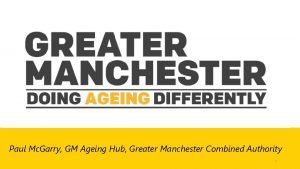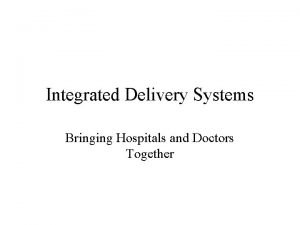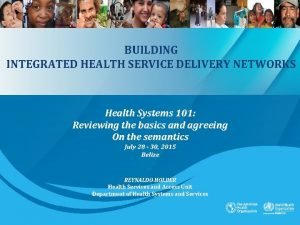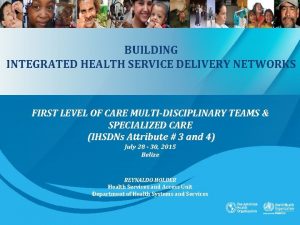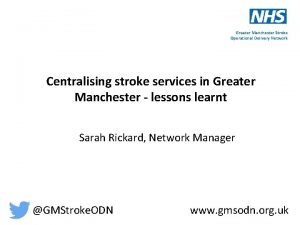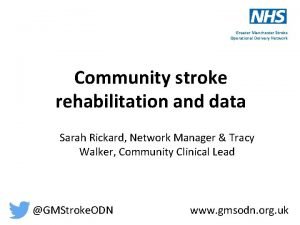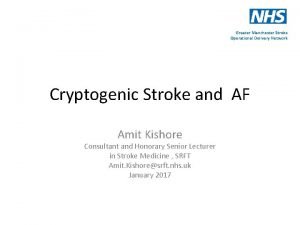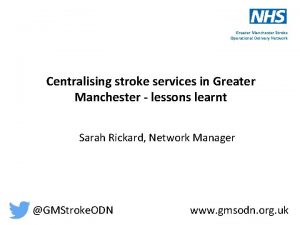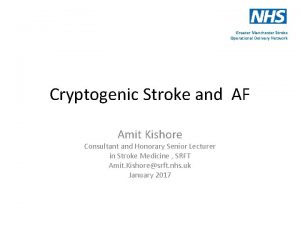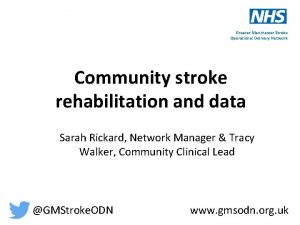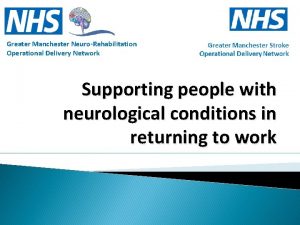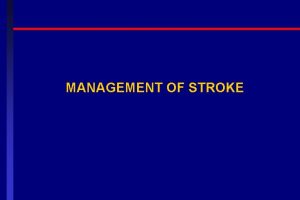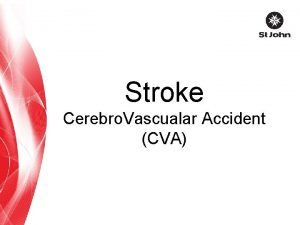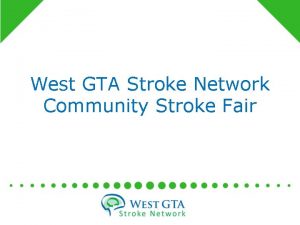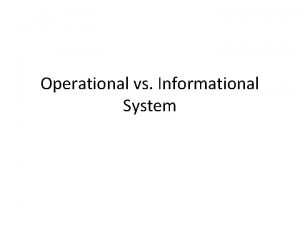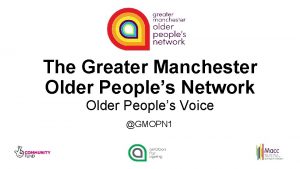Greater Manchester Stroke Operational Delivery Network The Greater




































- Slides: 36

Greater Manchester Stroke Operational Delivery Network The Greater Manchester Stroke Care Pathway Teaching tool for General Practice Audio presentation with notes and hyperlinks to resources www. gmsodn. org. uk @GMStroke. ODN

Greater Manchester Stroke Operational Delivery Network Understanding stroke Key statistics Types of stroke Impacts of stroke

Stroke statistics Greater Manchester Stroke Operational Delivery Network • >6, 000 people a year diagnosed in Greater Manchester • 1 in 7 people die within 30 days of discharge • 3 rd single largest cause of death and leading cause of disability nationally • State of the Nation – Stroke Association 2016 • SSNAP Annual Report 2015/16

Types of stroke Greater Manchester Stroke Operational Delivery Network • Ischaemic strokes are the commonest presentation (85%) - caused by a clot • Haemorrhagic strokes are less common (15%) caused by a bleed and generally more severe with a higher risk of mortality • A Transient Ischaemic Attack - symptoms usually last between minutes and hours • Stroke can be difficult to diagnose • NHS Choices Stroke Video • Stroke Association – What is a stroke?

Impacts of stroke Greater Manchester Stroke Operational Delivery Network • Stroke can have a range of physical impacts that can affect walking, speech, balance, vision, swallowing, bladder and bowel control • Impacts can also be psychological including fatigue, poor concentration, depression and anxiety • Access to psychological as well as physical support is vital for recovery • Stroke Association – Common problems after stroke

Greater Manchester Stroke Operational Delivery Network Assessment of stroke FAST assessment Other stroke symptoms Pathway to hospital

FAST assessment Greater Manchester Stroke Operational Delivery Network • Facial weakness – Can they smile evenly? • Arm weakness – Can they raise both arms and keep them there? Is there a weakness on one side? • Speech – Can they speak clearly? Is this slurred, muddled or jumbled? Can they speak at all? Can they understand you clearly? • Time – If any of the above are present ACT FAST and call 999 • NHS Choices ACT FAST

Other symptoms of stroke Greater Manchester Stroke Operational Delivery Network • Weakness/numbness or paralysis of the face, arm or legs on either or both sides of the body • Vertigo or spinning, loss of balance or an unexplained fall • Loss of vision, suddenly blurred or decreased vision in one or both eyes • Headache, usually severe and abrupt onset or unexplained change in the pattern of headaches • Difficulty swallowing

Pathway to hospital Greater Manchester Stroke Operational Delivery Network

Greater Manchester Stroke Operational Delivery Network The Greater Manchester stroke care pathway

Centralised acute care pathway Greater Manchester Stroke Operational Delivery Network Pre hospital phase Transfer to local hospital Acute hospital phase Discharge & rehabilitation

Greater Manchester Stroke Operational Delivery Network Stroke care in hospital Local stroke units Treatment of stroke Thrombolysis Transient Ischaemic Attack (TIA)

Local stroke units Greater Manchester Stroke Operational Delivery Network Hyper Acute Stroke Units • Salford Royal Hospital (blue) • Fairfield General and Stepping Hill Hospitals (purple) District Stroke Centres (teal) • Manchester Royal Infirmary • Royal Albert Edward Infirmary • Royal Bolton Hospital • Tameside General Hospital • Trafford General Hospital • University Hospitals of South Manchester Greater Manchester acute stroke pathway

Admission to hospital Greater Manchester Stroke Operational Delivery Network • Evidence shows patients with suspected acute stroke do better when they: – are assessed by a stroke team on arrival – receive a CT brain scan urgently within 1 hour of hospital admission – are admitted directly to a stroke unit within 4 hours • RCP National Clinical Guideline for Stroke 2016 (p 40) • Sentinel Stroke National Audit Programme

Treatment of stroke Greater Manchester Stroke Operational Delivery Network • Time is brain in stroke - 1. 9 million neurons die every minute a stroke is untreated • Thrombolysis dissolves blood clots and is licensed up to 4. 5 hours after onset of symptoms in the UK • It is delivered at our three HASUs • Only around 15% of stroke patients assessed will be eligible for thrombolysis • NHS Choices: Treating stroke

Thrombolysis Greater Manchester Stroke Operational Delivery Network • Patients are assessed by a HASU specialist stroke team in ED for suitability for thrombolysis as most benefit when given early • Aspirin should not be given in the acute stroke phase to any patient who may be suitable for thrombolysis • 2 -13% chance of bleed following thrombolysis • 1 in 5 people show significant improvement following thrombolysis, with 1 in 4 showing moderate improvement • 30% may show no improvement at all

Transient Ischaemic Attack (TIA) Greater Manchester Stroke Operational Delivery Network • Sudden, focal dysfunction (rarely global), vascular origin - usually lasting minutes or hours • Resulting from focal temporary cerebral ischaemia • Increases risk of having a stroke • TIA Clinic • RCP National Clinical Guidelines for Stroke 2016 (p 37)

ABCD 2 scoring for risk ABCD 2 score training Greater Manchester Stroke Operational Delivery Network

TIA management Greater Manchester Stroke Operational Delivery Network • TIA patients who resolve within 24 hours - aspirin 300 mg and assessed within 24 hours • Carotid imaging (Doppler) • Brain imaging in selected patients only • Secondary prevention as for stroke: • BP control • Statin • Smoking cessation • Anticoagulation for AF

Greater Manchester Stroke Operational Delivery Network Stroke care in the community Community rehabilitation The community team Life after stroke care

Community rehabilitation Greater Manchester Stroke Operational Delivery Network • Evidence shows patients do better when they: • are discharged into specialist community rehabilitation services • receive up to 45 minutes of therapy per professional group every day 5 days/week • receive support from a psychologist if needed • have their goals regularly reviewed • are supported to return to work • have a health and social care review at 6 months • RCP National Clinical Guidelines for Stroke 2016

Community teams Greater Manchester Stroke Operational Delivery Network • Greater Manchester has 16 community rehabilitation teams that support patients discharged from hospital or referrals from the community • Each area commissions different services • Work is underway to standardise post acute care in the region • Greater Manchester community rehabilitation services are collated in a local directory to help determine the right community team to refer patients into

Role of the community team Greater Manchester Stroke Operational Delivery Network • Provide early effective community rehabilitation • Offer a range of support to aid physical and emotional wellbeing and recovery • Provide advice and support with adapting to life after stroke e. g. return to work and driving • Refer to other NHS services • Refer to life after stroke services • Provide discharge information including unmet needs to GPs • Often conduct a review at 6 months

Life after stroke care Greater Manchester Stroke Operational Delivery Network • Life after stroke services complement and augment NHS care and are a key aspect of recovery • An online directory of local services is available • Local stroke support organisations include: – BASIC – brain injury support – Speakeasy – aphasia support – Think Ahead – Wigan area – Stroke Association – local and national support

Greater Manchester Stroke Operational Delivery Network Prevention of stroke Primary prevention Atrial fibrillation Blood pressure Lipid modification Antiplatelets Lifestyle

Primary prevention Greater Manchester Stroke Operational Delivery Network • Up to 80% of all strokes could be prevented • Demographic risk factors include: age; gender & ethnicity • Health risk factors include: previous stroke or TIA, high blood pressure, Atrial Fibrillation, diabetes, high cholesterol, sickle cell disease, obesity, smoking, alcohol and drug use • State of the Nation – Stroke Association 2016

Atrial fibrillation (AF) Greater Manchester Stroke Operational Delivery Network • Risk of stroke increases X 5 for people with AF • AF-related strokes can be more severe • Almost all ischaemic stroke survivors will be put on antiplatelet medication such as aspirin or clopidogrel • Around a third of people with AF are undiagnosed • If untreated, they are at a high risk of having a stroke • Stroke Association – AF: How can we do better?

Anti coagulation in AF • NICE states that patients in AF should be considered for anticoagulation • It continues to be under-prescribed, particularly in the elderly • 33% of eligible AF patients are not anticoagulated Greater Manchester Stroke Operational Delivery Network

Treatment of AF Greater Manchester Stroke Operational Delivery Network • Paroxysmal, persistent or permanent AF requires anticoagulation • Anticoagulation can be commenced 14 days after disabling stroke or sooner if less severe • Warfarin (INR 2. 5), Apixaban, Dabigatran, Edoxaban or Rivaroxaban • Use HAS-BLED and CHADSVASC tools to assess risk • Also consider Left Atrial Appendage closure • RCP National Clinical Guidelines for Stroke 2016 (p 97)

Blood pressure Greater Manchester Stroke Operational Delivery Network • High blood pressure is a contributing factor in half of strokes • 14% of the UK population have hypertension and a significant proportion remain undiagnosed • Commence treatment prior to discharge or within 2 weeks • Stroke survivors discharged home should be regularly reviewed in the community, especially during the first few weeks when their risk of re stroke is highest • This review should include adjustment of medication if required • State of the Nation – Stroke Association 2016

Blood pressure management Greater Manchester Stroke Operational Delivery Network • Aim for systolic BP < 130 mm. Hg – 140 -150 mm. Hg if bilateral severe carotid stenosis • Calcium channel blocker/thiazide diuretic if ≥ 55 years or Afro-Caribbean • ACE/ACEII if <55 years and not Afro-Caribbean • Monitoring at home may be appropriate • RCP National Clinical Guidelines for Stroke 2016 (p 93)

Antiplatelets Greater Manchester Stroke Operational Delivery Network • Patients with acute ischemic stroke are given aspirin 300 mg in hospital which should be continued for up to 2 weeks followed by Clopidogrel 75 mg daily in the longer term • If unable to tolerate Clopidogrel: 1. Aspirin 75 mg od + Dipyridamole MR 200 mg bd 2. Aspirin 75 mg od alone 3. Dipyridamole MR 200 mg bd alone • In ischaemic stroke with haemorrhagic transformation, long term antiplatelets should be used (if benefit outweighs risk) • RCP National Clinical Guidelines for Stroke 2016 (p 96)

Lipid modification Greater Manchester Stroke Operational Delivery Network • Lifestyle measures: – Exercise, diet, weight loss, reduced alcohol intake & smoking cessation • Atorvastatin 20 -80 mg • Aim for >40% reduction in non-HDL cholesterol • Avoid statins in Primary Intracerebral Haemorrhage • RCP National Clinical Guidelines for Stroke 2016 (p 95)

Lifestyle Greater Manchester Stroke Operational Delivery Network • Effective lifestyle interventions reduce the primary risk of stroke and may also reduce secondary risk • Smoking, lack of exercise, obesity and excess alcohol intake all increase the risk of stroke • 1 in 4 strokes are due to smoking, the risk normalises after stopping smoking for 5 years • High alcohol intake is associated with an increased risk of stroke • RCP National Clinical Guidelines for Stroke 2016 (p 108)

Greater Manchester Stroke Operational Delivery Network

Greater Manchester Stroke Operational Delivery Network Visit our network website: www. gmsodn. org. uk (register to access key information) Online training resources: http: //gmsodn. org. uk/trainingeducation-online-training-andresources/
 Equation digital manchester
Equation digital manchester Anterior stroke vs posterior stroke
Anterior stroke vs posterior stroke Gm health and social care partnership
Gm health and social care partnership Strategic planning workshop greater manchester
Strategic planning workshop greater manchester Greater manchester good employment charter
Greater manchester good employment charter Greater manchester ageing hub
Greater manchester ageing hub Accenture delivery suite policy
Accenture delivery suite policy What are the advantages of an integrated delivery network?
What are the advantages of an integrated delivery network? Integrated delivery
Integrated delivery Health service delivery network
Health service delivery network First level service
First level service Slidetodoc.com
Slidetodoc.com Hình ảnh bộ gõ cơ thể búng tay
Hình ảnh bộ gõ cơ thể búng tay Slidetodoc
Slidetodoc Bổ thể
Bổ thể Tỉ lệ cơ thể trẻ em
Tỉ lệ cơ thể trẻ em Voi kéo gỗ như thế nào
Voi kéo gỗ như thế nào Tư thế worm breton là gì
Tư thế worm breton là gì Hát lên người ơi
Hát lên người ơi Các môn thể thao bắt đầu bằng từ đua
Các môn thể thao bắt đầu bằng từ đua Thế nào là hệ số cao nhất
Thế nào là hệ số cao nhất Các châu lục và đại dương trên thế giới
Các châu lục và đại dương trên thế giới Công thức tiính động năng
Công thức tiính động năng Trời xanh đây là của chúng ta thể thơ
Trời xanh đây là của chúng ta thể thơ Cách giải mật thư tọa độ
Cách giải mật thư tọa độ Làm thế nào để 102-1=99
Làm thế nào để 102-1=99 độ dài liên kết
độ dài liên kết Các châu lục và đại dương trên thế giới
Các châu lục và đại dương trên thế giới Thơ thất ngôn tứ tuyệt đường luật
Thơ thất ngôn tứ tuyệt đường luật Quá trình desamine hóa có thể tạo ra
Quá trình desamine hóa có thể tạo ra Một số thể thơ truyền thống
Một số thể thơ truyền thống Cái miệng bé xinh thế chỉ nói điều hay thôi
Cái miệng bé xinh thế chỉ nói điều hay thôi Vẽ hình chiếu vuông góc của vật thể sau
Vẽ hình chiếu vuông góc của vật thể sau Thế nào là sự mỏi cơ
Thế nào là sự mỏi cơ đặc điểm cơ thể của người tối cổ
đặc điểm cơ thể của người tối cổ Ví dụ giọng cùng tên
Ví dụ giọng cùng tên Vẽ hình chiếu đứng bằng cạnh của vật thể
Vẽ hình chiếu đứng bằng cạnh của vật thể





